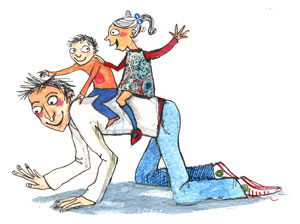The interface between rider and horse can be explained by this:
Imagine having a 5 year old on your back that is set to control your every move entirely by pulling on your nose and ears and kicking you in the sides. You have no choice, and must do what they ask… without actually knowing it is right, just experimenting to see if this is it. Imagine how easy it would be to do this with a well trained five year old. he learns to lean and only pulls on your ears and nose a little bit and off you go. Feeling for every subtle nuance of their position, soon you are able to be guided through the most complex of actions. As your 5 year old ages a bit and really comes into his own you are able to jump around sling yourself around corners without him falling off. He shiftys his weight and you are able to easily turn and spin, a quick indication and off you go hell bent for leather until a quick shift of his hips and you know to stop quickly and he won’t go ass over teakettle off the top.
Now swap the brains, 5 year old on bottom, you on top and you might get the idea (though I’d argue that no brain swap is really necessary, new riders ride like 5 year olds). A horse is smart, some smarter than others. They will get frustrated (imagine yourself after five minutes of this, dumping the 5 year old in the trash—-yes I see the smile) Notice how this relationship gets better as the 5 year old gets better trained. Lets face it, an adult should be able to figure out where and how a 5 year old wants to go if we think hard.
This is how it is for a horse. He is far smarter and capable to doing exactly what to ask after a small amount of training, IF you are great rider and know how to ask properly. The less a rider you are, the harder it is to communicate. That horse is smart, you start off un-educated. Your job is to educate yourself on horse communication. then you can really ride.

